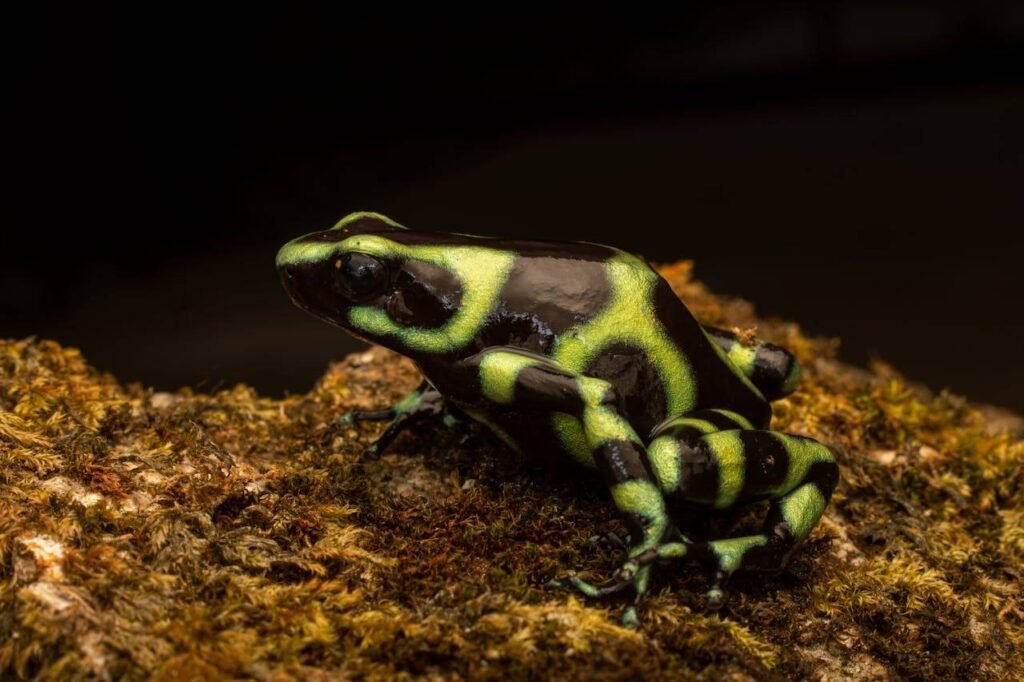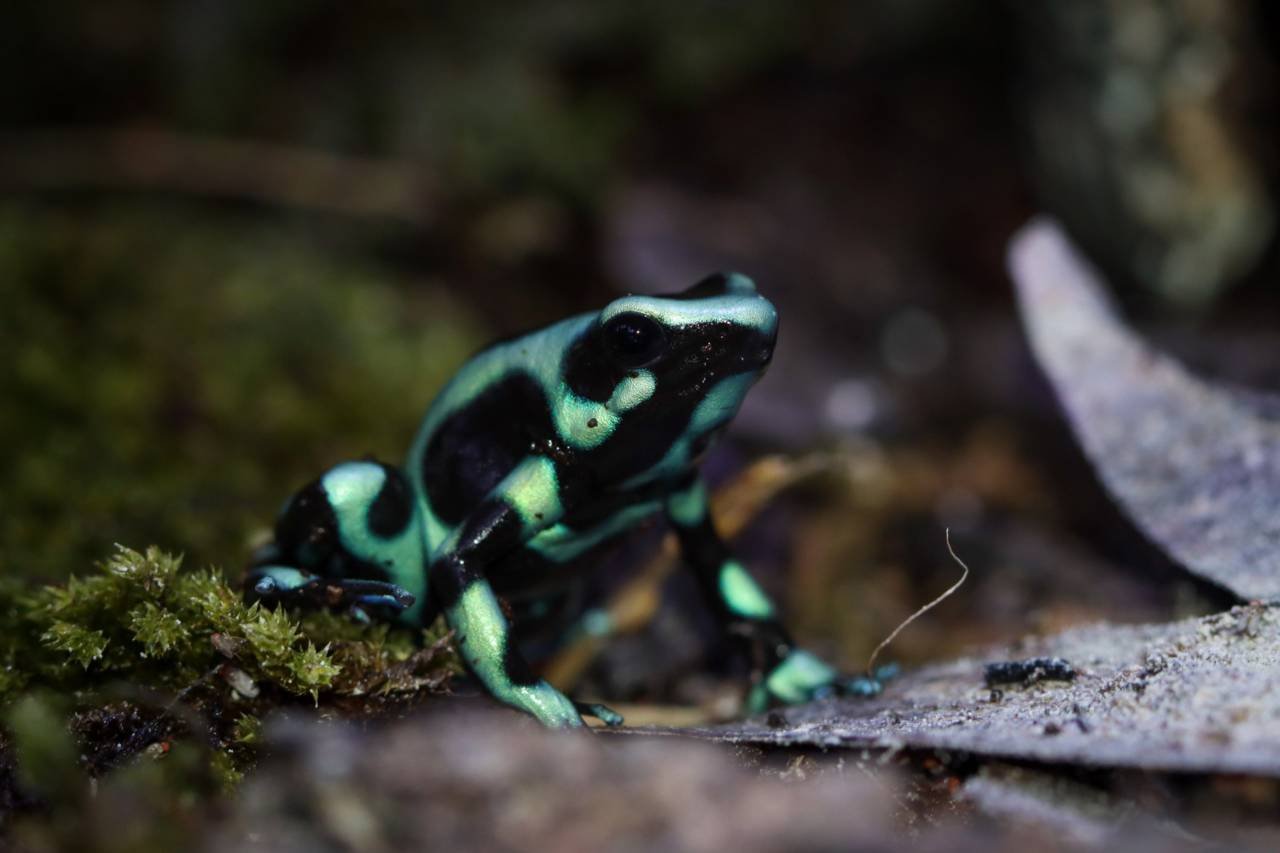The Green and Black Poison Dart Frog, scientifically known as Dendrobates auratus, is a captivating amphibian that stands out with its striking colors and unique ecological role. Native to Central and South America, this species is both a visual delight and an essential component of its ecosystem. Let’s explore the fascinating attributes of the Green and Black Poison Dart Frog and its place in the natural world.
Characteristics and Appearance
The Green and Black Poison Dart Frog is easily recognizable by its vibrant green body adorned with irregular black blotches. The shade of green can vary significantly, ranging from lime to emerald, depending on the frog’s geographic location. This aposematic coloration serves as a warning to potential predators of the frog’s toxicity. Adults typically measure between 1 to 2 inches in length.


Habitat and Distribution
Green and Black Poison Dart Frogs inhabit the tropical rainforests of Central America, including Costa Rica and Panama. They thrive in humid environments, often near streams and small bodies of water that provide ideal breeding conditions. Their habitat is characterized by dense foliage, which offers cover and access to the insects that form their diet.
Toxicity and Diet
Like other poison dart frogs, the Green and Black Poison Dart Frog is known for its skin toxins, which deter potential predators. These toxins are derived from their diet of alkaloid-rich insects such as ants, mites, and beetles. Despite their toxicity, they are not dangerous to humans unless handled improperly.
Reproduction and Life Cycle
During the rainy season, male Green and Black Poison Dart Frogs establish territories and call to attract females. Once a female responds, the pair engages in a courtship ritual that leads to egg-laying. Females deposit eggs in moist locations, such as leaf litter or bromeliads. After hatching, the male typically transports the tadpoles on his back to aquatic environments where they continue to develop.
Acquiring Green and Black Poison Dart Frogs as Pets
While the Green and Black Poison Dart Frog is an intriguing and beautiful amphibian that some enthusiasts may consider keeping as a pet, there are important considerations and responsibilities involved in acquiring such an exotic animal.
Where to Buy
Green and Black Poison Dart Frogs can sometimes be purchased from specialized breeders or exotic pet stores that focus on amphibians. It’s crucial to choose a reputable breeder who can provide evidence that the frogs were captive-bred, as this practice supports conservation efforts by not removing specimens from the wild.
Considerations for Potential Owners
- Housing:
Dart frogs require a carefully controlled environment, often facilitated by a terrarium that maintains high humidity and moderate temperatures, replicating their natural rainforest habitat. - Diet:
In captivity, these frogs need a diet of small invertebrates like fruit flies and pinhead crickets. They will not naturally develop the toxins associated with their wild counterparts due to the lack of specific alkaloid-rich insects in their diet. - Legal Regulations:
Before acquiring a poison dart frog, it’s essential to check local regulations, as permits or specific conditions for ownership might be required. - Commitment:
Owning a poison dart frog is a long-term commitment, with many living 10 years or longer in captivity with proper care. Prospective owners should be committed to providing ongoing, appropriate care and maintenance.
Ethical and Conservation Considerations
As with any exotic pet, ethical considerations play a significant role. Prospective owners should prioritize species that are captive-bred and contribute positively to conservation efforts. It’s important to be mindful of the ecological impact and responsibilities associated with owning a species that represents such a vital part of their natural ecosystem.
Conservation Status in Nature
While not currently considered endangered, the Green and Black Poison Dart Frog faces threats from habitat loss and environmental changes. Conservation efforts are essential to safeguard their natural habitats and ensure the survival of their populations.
Related Topics and Entertaining Reads
To discover more about other fascinating poison dart frog species, explore our in-depth article on poisonous dart frogs. For more fun and engaging content, don’t miss our collection of frog jokes and enchanting frog-themed fairy tales that offer delightful and imaginative escapes.
FAQs About Green and Black Poison Dart Frogs
What makes Green and Black Poison Dart Frogs toxic?
These frogs derive their toxicity from a diet of alkaloid-rich insects found in their natural habitats, using their bright colors to warn predators of their poisonous nature.
Are Green and Black Poison Dart Frogs dangerous to humans?
While they possess toxins, they are not dangerous to humans unless ingested or if their toxins come into contact with open wounds.
How do these frogs reproduce?
Reproduction typically occurs during the rainy season, with males calling to attract females. After mating, females lay eggs in moist environments, and males transport the hatched tadpoles to water sources.
Why are Green and Black Poison Dart Frogs important to their ecosystem?
They play a crucial role in controlling insect populations and serve as both predator and prey within their ecosystem, contributing to environmental health.
What conservation efforts are in place for these frogs?
Efforts include habitat preservation and raising awareness of their ecological importance to protect frog populations and their rainforest environments.
How does the geographical location affect the coloration of these frogs?
The shade of green on Green and Black Poison Dart Frogs can vary depending on their geographic location, ranging from lime to emerald hues, which may offer different levels of camouflage or attraction.
Can the Green and Black Poison Dart Frogs be kept as pets?
While some hobbyists do keep poison dart frogs, including Green and Black ones, as pets, it requires specialized care, including a controlled environment and specific diet that doesn’t mimic their natural alkaloid-rich sources, making them non-toxic in captivity.
What do Green and Black Poison Dart Frogs eat in the wild?
In their natural habitat, these frogs primarily eat ants, mites, and other small insects, which provide them with the alkaloids necessary for producing their toxins.
How can habitat loss impact the Green and Black Poison Dart Frog?
Habitat loss, often due to deforestation and human encroachment, reduces the availability of natural resources and breeding sites, posing a threat to their populations.
Are there natural predators that prey on these frogs?
While their bright coloration deters most predators, some specialized snakes and birds have developed resistance to their toxins and can prey on them.

